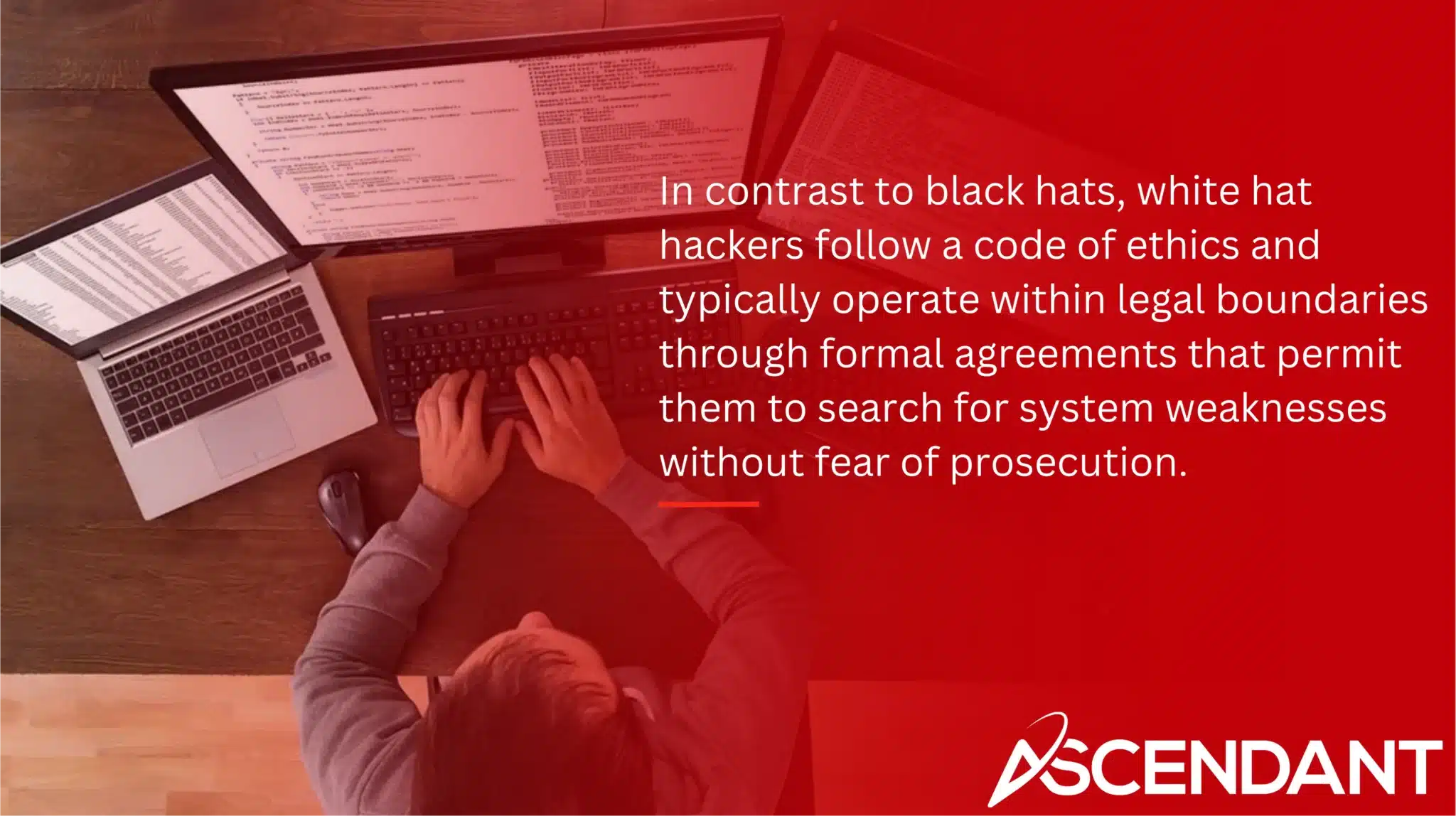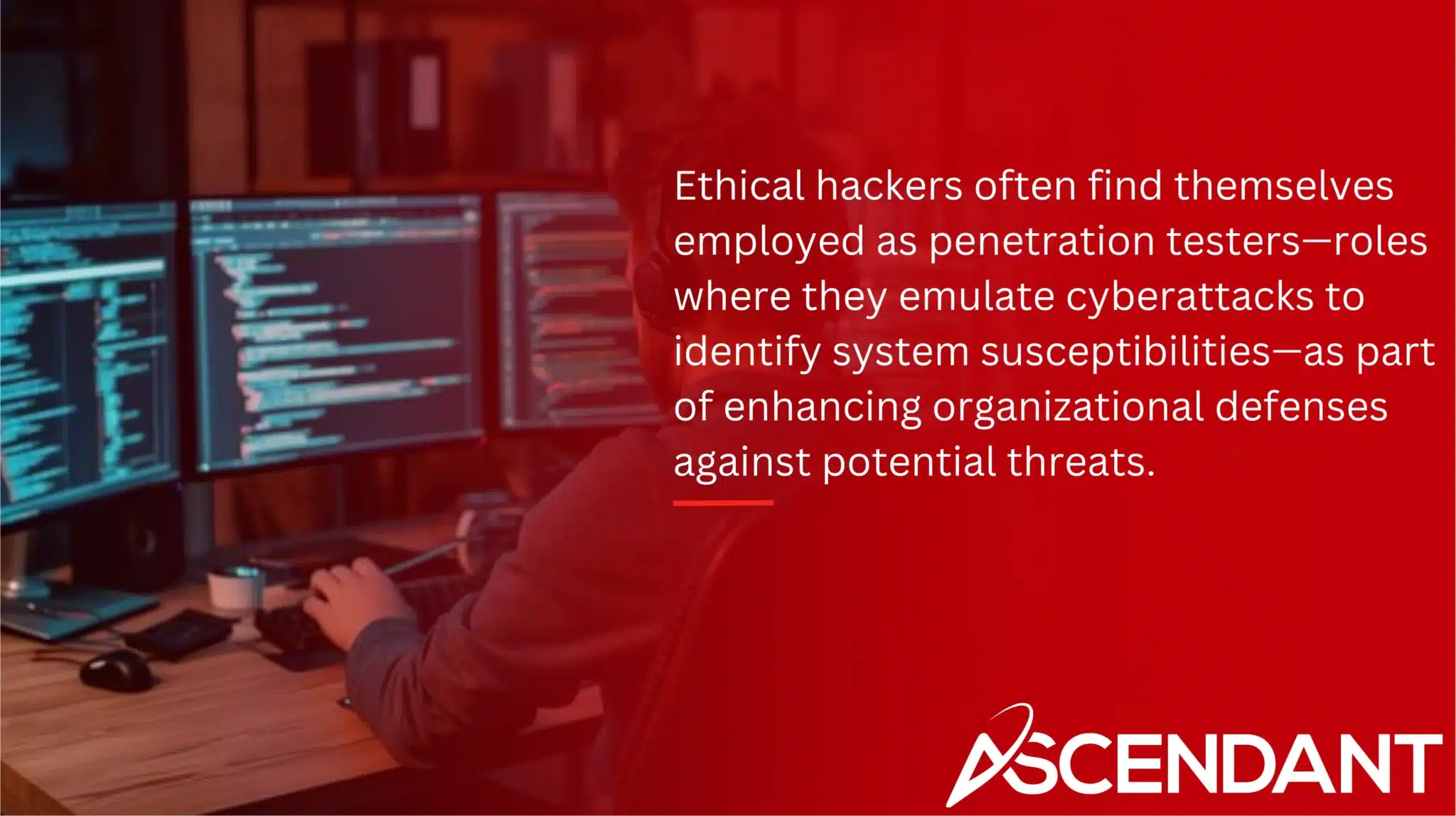A white hat hacker is a cybersecurity expert who uses their skills to protect systems and networks from threats. Unlike black hat hackers, who exploit vulnerabilities for personal gain, white hat hackers operate ethically to identify and fix security flaws. This article will help you understand the role, skills, and tools of white hat hackers.
Key Takeaways
- White hat hackers operate ethically to identify and rectify security vulnerabilities, contrasting with black hat hackers who exploit them for personal gain.
- Essential skills for white hat hackers include technical proficiency in programming, practical experience through simulations, and continuous learning to keep up with evolving cyber threats.
- Bug bounty programs facilitate a collaborative approach to cybersecurity, allowing organizations to leverage global ethical hackers for identifying vulnerabilities and enhancing overall security.
Understanding White Hat Hackers
Black hat hackers are nefarious individuals who capitalize on security weaknesses for illicit gain. They scour systems to exploit vulnerabilities and may cause substantial harm or theft. Conversely, white hat hackers dedicate their expertise to detect and repair these same security flaws before they can be used maliciously. This proactive defense against cyber threats is essential in fortifying the protection of organizational infrastructures.

In contrast to black hats, white hat hackers follow a code of ethics and typically operate within legal boundaries through formal agreements that permit them to search for system weaknesses without fear of prosecution. These ethical experts then responsibly report any discovered vulnerabilities so that organizations can address them swiftly, thus mitigating potential risks posed by less scrupulous individuals.
The intention behind one’s actions is the dividing line between hacker classifications. While black hats pursue detrimental exploits often driven by self-interests, white hats apply similar skills toward constructive ends—identifying and remedying faults in our digital defenses. Their commitment serves as a shield against those seeking to leverage technology for adverse purposes, ensuring cyberspace remains safer from the various predatory tactics employed by malign actors.
Key Differences Between White, Black, and Gray Hat Hackers
In the realm of hacking, there are three primary types: white hat hackers, black hat hackers, and gray or grey hat hackers. It’s essential to recognize their differences to understand the moral framework within which white hat hackers operate.
Engaged in enhancing security measures with consent, white hat hackers typically perform security assessments for organizations seeking to fortify their cyber defenses against attacks. On the flip side, black hat hackers infiltrate systems with malicious intent—for instance—seeking financial gain or aiming to create disruption by clandestinely selling discovered vulnerabilities and posing substantial risks in cybersecurity landscapes.
Gray or grey hat hackers represent a nuanced category that combines aspects of ethical hacking and unauthorized access. They may believe their actions serve a greater good, but often navigate without permission. This complicates ethical boundaries they tread upon. In contrast to the transparency and professional ethics exhibited by white hats who responsibly disclose system weaknesses, gray hats do not consistently follow such protocols—a factor separating them from both altruistic white hats and nefarious black hats alike.
Essential Skills for White Hat Hackers
Ethical hackers must possess a robust technical foundation, with in-depth knowledge of computer systems, networking, and code writing. Mastery over programming languages like Python, JavaScript, C++, and assembly language is essential for pinpointing and manipulating security loopholes.
Hands-on experience holds equal weight. White hat hackers typically hone their skills through laboratory settings and participating in Capture The Flag (CTF) events that mimic real-life challenges within safe environments. Staying abreast of the ever-shifting cyber threat landscape by learning new cybersecurity trends and methods is vital as well.
Interacting with fellow professionals in the field can be immensely beneficial to aspiring ethical hackers by providing critical insights and employment prospects. By exchanging expertise with peers, they are able to stay ahead of novel threats while refining their competencies continuously. Their ultimate mission is uncovering and fixing security vulnerabilities to fortify protection against imminent cyber risks.
Tools Used by White Hat Hackers
Ethical hackers, also known as white hat hackers, deploy a plethora of tools to pinpoint and exploit security flaws. Among them is the indispensable Metasploit framework, which aids in penetration testing by allowing ethical hackers to craft and implement exploit code. This tool stands out as a foundational element in the toolkit for conducting robust examinations of security measures.
Nmap emerges as another essential instrument for ethical hackers with its stellar port scanning functionality. It empowers them to define network architectures and spot probable access points into systems. Nessus plays an integral role due to its prowess in uncovering pressing security vulnerabilities, rendering it vital for any white hat hacking endeavor.
When delving into web application security specifics, both Burp Suite and Nikto prove crucial. The former provides extensive auditing capabilities that unearth web app vulnerabilities. Meanwhile, Nikto excels at recognizing obsolete software along with miscellaneous susceptibilities on assorted servers.
Rounding off this suite of paramount tools are Wireshark—specializing in scrutinizing network traffic—as well as Cain & Abel focused on retrieving passwords, together with SQLMap dedicated to finding and leveraging SQL Injection weaknesses. Employed collectively by white hat hackers during their meticulous security assessments ensure fortification against cyber threats across various fronts.
Techniques White Hat Hackers Use
Ethical hacking involves white hat hackers employing a range of strategies to detect and rectify security flaws. One prevalent strategy is social engineering, which leverages the human aspect of cybersecurity by coaxing individuals into disclosing sensitive information, often highlighting vulnerabilities that cannot be resolved through technology alone.
Utilizing reverse engineering is also essential for these ethical hackers as it grants them the ability to disassemble software and seek out its weaknesses. This approach facilitates understanding complex systems and crafting effective countermeasures against potential cyber threats.
With advancements in artificial intelligence (AI) and machine learning, ethical hacking has experienced significant improvements. AI-driven algorithms augment password cracking efforts by pinpointing prevailing patterns in passwords and uncovering frailties within account safeguards. These progressive tools empower white hat hackers with enhanced abilities to conduct more nuanced analyses and fortify security protocols, combining time-honored hacking methods with avant-garde technologies ensures these professionals remain at the forefront of thwarting new-age cyber dangers.
How to Become a Certified Ethical Hacker
Having a deep-rooted dedication to security and maintaining an ethical approach is essential for those aspiring to become certified ethical hackers. While some may transition from the world of black hat hacking following legal repercussions, adopting white hat practices, others begin their journey with inherent moral principles aimed at defending digital environments.
To validate one’s technical proficiency in this field, acquiring recognized certifications such as the Certified Ethical Hacker (CEH) or Offensive Security Certified Professional (OSCP) is imperative. These accreditations pave the way for myriad opportunities within the realm of cybersecurity. White hat hackers frequently engineer test scenarios that enable them to hone their capabilities further. Engaging in Capture The Flag (CTF) events provides valuable hands-on experience reflective of authentic cyber challenges.

Ethical hackers often find themselves employed as penetration testers—roles where they emulate cyberattacks to identify system susceptibilities—as part of enhancing organizational defenses against potential threats. By perpetually updating their knowledge base and adjusting tactics in response to emerging risks, these skilled practitioners are integral defenders against attacks on our interconnected digital landscape.
Legal Considerations in White Hat Hacking
It is crucial for white hat hackers, also known as ethical hackers, to operate within the confines of both ethics and law. These individuals must gain explicit permission before attempting to penetrate any system in order to remain compliant with laws like the Computer Fraud and Abuse Act (CFAA), which explicitly defines what constitutes unauthorized access.
Ethical hackers are obligated to keep detailed records of their penetration testing activities to provide evidence that they adhere strictly to legal stipulations. They should carry out their work with full transparency, meticulously reporting any discovered vulnerabilities while adhering closely to regulatory guidelines such as those set by GDPR and security standards including NIST SP 800-53—all aimed at safeguarding sensitive data.
The use of bug bounty programs serves as an organized method for disclosing found security issues whilst mitigating against potential legal complications. Adhering firmly to these practices allows ethical or white hat hackers not only avoid being mistaken for cybercriminals, but also contribute meaningfully towards enhancing cybersecurity measures.
Famous White Hat Hackers and Their Contributions
Numerous ethical hackers, also known as white hat hackers, have made invaluable contributions to the realm of cybersecurity. Among them is Steve Wozniak, who not only co-founded Apple but is also celebrated for his pioneering efforts in ethical hacking. His influence has deeply affected technological advancement and underscores the critical role that ethical hacking plays in both innovation and securing technologies.
Achieving a certification like Certified Ethical Hacker (CEH) can significantly propel an ethical hacker’s career forward. Such certifications serve to acknowledge the skills and knowledge of these professionals, paving their way into prominent roles within top organizations in the cybersecurity sector.
Companies that implement bug bounty programs are actively demonstrating their dedication to maintaining robust security measures while simultaneously building credibility with clients and partners. These initiatives invite collaboration from skilled ethical hackers by incentivizing them to discover and report system weaknesses—thereby advancing collective security defenses against potential threats.
The Role of Bug Bounty Programs
Utilizing the skill set of ethical hackers from around the globe, bug bounty programs significantly bolster cybersecurity. These programs operate on a model where payment is issued only when legitimate vulnerabilities are identified by ethical hackers, which proves to be an economical strategy for organizations that results in ongoing security evaluation and immediate discovery of security gaps as threats progress.
Ethical hacking taps into a wide spectrum of expertise unavailable within internal teams, enabling detection of issues that might otherwise go unnoticed. The collective knowledge and varied abilities contributed through bug bounty initiatives yield thorough security audits and ensure companies remain at the forefront of combating newly emerging cyber risks.
By engaging with these programs, enterprises gain crucial insights regarding their security posture while also showcasing their dedication to cybersecurity practices. Such preventive measures foster confidence among consumers and business partners alike, underlining the pivotal role ethical hacking plays in maintaining integrity within our increasingly digital world.
The Future of White Hat Hacking
Advancements in AI and new technologies are set to redefine the landscape of white hat hacking. Through the power of AI, intricate personal information, trade secrets, or system vulnerabilities can be uncovered that pave the way for more nuanced and formidable cyber threats. By utilizing AI to collect extensive datasets and scrutinize them meticulously, hackers gain a heightened capability for launching attacks that are both accurate and destructive.
Emerging dangers such as deepfake technology broaden the spectrum of possible cyber risks by enabling counterfeit content creation used to mimic individuals deceitfully or propagate false information. Polymorphic malware poses an intensified risk due to its capacity to elude standard antivirus software detection measures. The automation driven by artificial intelligence simplifies orchestrating widespread cyber offenses with relatively little input required—compelling ethical hackers otherwise known as white hat hackers—to perpetually refine their skills in defense against these evolving threats.
As we face mounting challenges within cyberspace protection, it is clear that ethical hackers stand at the forefront in defending our digital ecosystem. Employing cutting-edge tools while proactively keeping abreast with newly arising threats enables white hat hackers to strengthen cybersecurity defenses against potential system vulnerabilities effectively. Going forward into this dynamic future dominated by novel forms of cyber onslaughts demands a united front where collaboration is key. It requires constant educational advancement alongside staunch adherence to ethical standards amongst those committed professionals working tirelessly behind computer screens—the guardians who navigate through tumultuous seas rife with relentless waves of cybersecurity perils.
Summary
Throughout this article, the crucial contribution of white hat hackers to the realm of cybersecurity has been thoroughly examined. Delving into their adherence to ethical principles and how they are distinguished from black and gray hat hackers, we’ve seen just how vital these individuals are for defending our digital infrastructures and enhancing overall security measures.
We’ve touched on key elements such as necessary certifications, legal considerations surrounding ethical hacking practices, along with recognizing prominent figures in the field who have made significant contributions. The discussion extended to bug bounty programs and anticipated developments within white hat hacking that underscore the persistent need for skilled ethical hackers ready to confront new waves of cyber threats.
Looking ahead at what’s coming up on the horizon for cybersecurity necessitates an ongoing dedication to principles governing ethical hacking alongside a commitment towards perpetual education in this sector. Embracing these cornerstones is imperative if we aim to maintain a robust and reliable cyberspace defense mechanism well into future advancements.
 Frequently Asked Questions
Frequently Asked Questions
What is the primary difference between white hat and black hat hackers?
The primary difference is that white hat hackers enhance security with permission, whereas black hat hackers exploit systems for malicious purposes and personal gain.
How can I become a certified ethical hacker?
In order to achieve the status of a certified ethical hacker, one should pursue and acquire credentials like the Certified Ethical Hacker (CEH) or Offensive Security Certified Professional (OSCP). Alongside these certifications, it is crucial to engage in practical exercises such as setting up labs and participating in Capture The Flag (CTF) contests.
Through this fusion of formal certification and direct experience, your expertise and professional standing within the realm of ethical hacking will be significantly bolstered.
What are some essential tools used by white hat hackers?
Essential tools used by white hat hackers include Metasploit, Nmap, Nessus, Burp Suite, and Wireshark, which help in identifying and exploiting system vulnerabilities.
These tools are vital for enhancing cybersecurity and protecting against malicious attacks.

